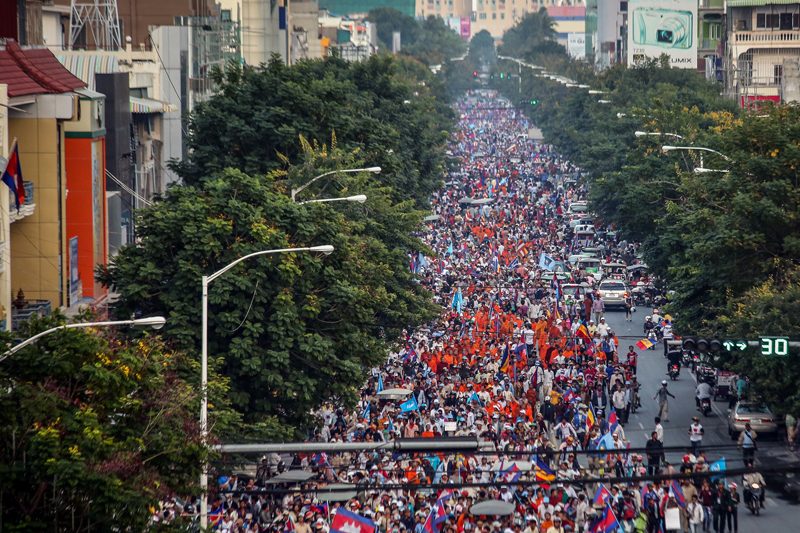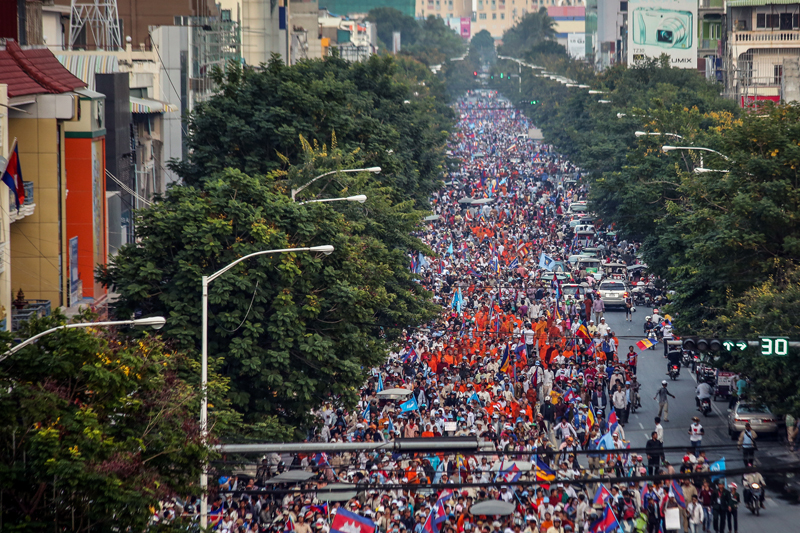In August 2013, CNRP leaders told about 10,000 supporters in Phnom Penh’s Freedom Park that the party would ramp up demonstrations if the CPP did not agree to an impartial investigation of the disputed national election.
Momentum had been building since rowdy street campaigns before the election, and when the ruling party refused the opposition’s demands, discontent exploded in the form of massive protests targeting Prime Minister Hun Sen.

“We will walk on every street and shout: ‘Hun Sen, step down!’” opposition leader Sam Rainsy told thousands of emboldened supporters as “non-stop” protests began in December, culminating in some 50,000 people marching through the streets on December 22—the largest anti-government demonstration in at least 15 years.
Almost three years later, with the government launching a legal assault against leaders of the opposition, the CNRP is again threatening mass demonstrations.
“If you consider that it is right, we must arrange mass demonstrations like 2013 and early 2014,” Mr. Rainsy, speaking via video link from France, told youth activists gathered at the CNRP’s headquarters last week.
But the circumstances could hardly be more different.
Mr. Rainsy, who was pardoned and allowed to return to the country weeks before the 2013 election, is again living outside the country to avoid prison. Deputy opposition leader Kem Sokha, sentenced last week to five months in prison, remains locked down in the party’s Phnom Penh headquarters. And while the government tolerated growing public discontent for months in 2013—before brutally suppressing protests in January 2014—it has made clear that it has no intention of allowing the events to repeat.
“History’s happened; now everyone can learn from it; the authorities won’t allow anything like what happened in 2013 to repeat itself,” Sophal Ear, an associate professor of diplomacy and world affairs at Occidental College in Los Angeles, said in an email.
“They’ll overreact in all likelihood to signal how strongly they can’t allow anything remotely like what happened in 2013 from happening again,” he said.
The reaction began almost as soon as the CNRP raised the prospect of demonstrations. Mr. Hun Sen posted a message to Facebook on Monday night, along with photographs of himself dressed in full military uniform, promising to prevent any protests against his government.
“It is more serious than a threat,” the prime minister said. “It is an order to ensure all government forces are ready to get rid of all forces that are acting to destroy national security and I have the right to say it like this because it is the authority of the prime minister.”
Hours later, dozens of trucks with masked and heavily armed soldiers were deployed outside the CNRP headquarters while speedboats mounted with machine guns passed the back of the building on the Tonle Bassac river.
“All branches of the armed forces are ready,” CPP spokesman Sok Eysan said this week in response to the CNRP’s pledge to hold mass protests. “They are only waiting for orders.”
All things considered, the chance of the opposition being able to bring tens of thousands onto the streets seems unlikely, but not impossible, said Mr. Ear, noting that the murder of popular political analyst Kem Ley in July inspired a huge show of public mourning.
“There’d have to be another incident to turn people’s grief into anger, which would lead to street protests,” he said. With wages steadily rising in the garment sector, he said the opposition would also struggle to rally workers as it did in 2013.
Ou Virak, head of the Future Forum public policy think tank, said he didn’t know “where the momentum would come from.”
“The demonstrations of 2013, they were actually riding on the huge momentum of the election and with the arrival of Sam Rainsy. The mood that was on the streets of the rallies was huge,” he said. “That’s not the case now. I don’t see where the momentum is coming from, but that doesn’t mean it doesn’t exist.”
Both Mr. Ear and Mr. Virak said the lack of visible leadership made the likelihood of large-scale opposition protests remote, noting the threats felt particularly weak coming from Mr. Rainsy.
“I think everyone would love that, sitting comfortably in beautiful Paris and calling for mass demonstration,” Mr. Virak said. “At the end of the day, I think there’s a lack of leadership and I think people will probably support it in spirit but not by going on the streets.”
Asked how confident he was in the CNRP’s ability to mobilize supporters as it did after the election, and whether he was concerned for the safety of supporters if they did take to the streets, Mr. Rainsy said only that he would “endorse any decision made by my colleagues on the spot.”
Government spokesman Phay Siphan said the 2013 protests were a “lesson learned” for the ruling party.
“They tried a coup d’etat against the result of the election. They went against the will of the people,” he said. “They destroyed democracy.”
Asked why the government was so wary of the CNRP again taking to the streets, Mr. Siphan said Mr. Rainsy planned to “destroy the Cambodian way of life.”
“If everyone throughout the country held a mass demonstration…the government will not have the ability to manage it,” he said. “That’s why they want to see anarchy happen in Cambodia.”
CNRP lawmaker Ou Chanrath said mass protests would be driven by the rising frustration among the public, and that the threat of armed force by the government only increased the opposition’s resolve.
“I don’t think the threat to use the armed forces or weapons will make people afraid,” he added. “Instead, it will increase the people’s hatred.”
(Additional reporting by Ben Sokhean)




